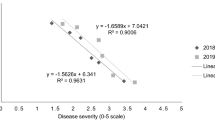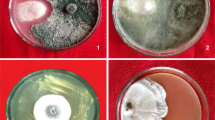Abstract
Combined application of biocontrol agents (BCAs) have been used to exploit their synergistic potential. But the analysis of additive, synergistic and antagonistic effects of BCAs has rarely been explored for the biocontrol of plant diseases. This study was conducted to evaluate in vitro and in vivo biocontrol potential of the combined application of Trichoderma harzianum strain Th3 and Pseudomonas fluorescens strain RRb11, and the fungicide carbendazim against the rice blast (RB) pathogen, Magnaporthe oryzae, and the bacterial leaf blight (BLB) pathogen, Xanthomonas oryzae pv. oryzae. Combined application of T. harzianum Th3 and P. fluorescens RRb11 synergistically reduced severity of RB by 69.5% in comparison to the untreated control, displaying a synergy factor (SF) of 1.29. P. fluorescens RRb 11 alone and in combination with T. harzianum Th3 and the mixture of T. harzianum Th3 + carbendazim was antagonistic (SF = 0.71 and 0.45, respectively). The combined application of T. harzianum Th3 and P. fluorescens RRb 11 also enhanced several rice plant growth and yield parameters. Additive, synergistic or antagonistic effects among the two BCAs were assessed by applying the numerical hypothesis of ‘Bliss Independence’ which suggested that the combined application of the two BCAs was synergistic in reducing RB but antagonistic with respect to BLB. Out of the six combined application interactions for both the diseases only one interaction (T. harzianum Th3 and P. fluorescens RRb11) was synergistic against RB, which suggested that synergism is a rare event in combined use of BCAs.


Similar content being viewed by others
References
Alabouvette, C., Lemanceau, P., & Steinberg, C. (1996). Biological control of fusarium wilds: Opportunities for developing a commercial product. In R. Hall (Ed.), Principles and practice of managing soilborne plant pathogens (pp. 192–212). St Paul: APS Press.
Alizadeh, H., Behboudi, K., Ahmadzadeh, M., Javan-Nikkhah, M., Zamioudis, C., Pieterse, C. M. J., & Bakker, P. A. M. (2013). Induced systemic resistance in cucumber and Arabidopsis thaliana by the combination of Trichoderma harzianum Tr6 and Pseudomonas sp. Ps14. Biological Control, 65, 14–23.
Becquer, C. J., Lazarovits, G., & Lalin, I. (2013). In vitro ineractions between Trichoderma harzianum and plant growth promoter rhizosphere bacteria. Cuban Journal of Agricultural Science, 47(1), 97–103.
Chemeltorit, P. P., Mutaqin, K. H., & Widodo, W. (2017). Combining Trichoderma hamatum THSW13 and Pseudomonas aeruginosa BJ10-86: a synergistic chilli pepper seed treatment for Phytophthora capsici infested soil. European Journal of Plant Pathology, 147, 157–166.
Chowdappa, P., Kumar, S. P. M., Lakshmi, M. J., & Upreti, K. K. (2013). Growth stimulation and induction of systemic resistance in tomato against early and late blight by Bacillus subtilis OTPB1 or Trichoderma harzianum OTPB3. Biological Control, 65, 109–117.
Contreras Cornejo, H. A., Ortiz Castro, R., & Lopez Bucio, J. (2013). Promotion of plant growth and the induction of systemic defence by Trichoderma: Physiology, genetics and gene expression. In P. K. Mukherjee (Ed.), Trichoderma biology and applications (pp. 175–196). London: CABI.
Doni, F., Isahak, A., Zain, C. R. C. M., & Yusoff, W. M. W. (2014). Physiological and growth response of rice plants (Oryza sativa L.) to Trichoderma spp. inoculants. AMB Express, 4, 45. https://doi.org/10.1186/s13568-014-0045-8.
Dubey, S. C., Singh, V., Priyanka, K., Upadhyay, B. K., & Singh, B. (2015). Combined application of fungal and bacterial bio-agents, together with fungicide and Mesorhizobium for integrated management of fusarium wilt of chickpea. Biocontrol, 60(3), 413–424.
Howell, C. R. (1998). The role of antibiosis in biocontrol. In G. E., Harman & C. P. Kubicek (Eds.), Trichoderma and Gliocladium Vol 2, (pp. 173–184). London: Taylor and Francies.
Hubbard, J. P., Harman, G. E., & Hadar, Y. (1983). Effect of soilborne Pseudomonas spp. on the biological control agent, Trichoderma hamatum, on pea seeds. Phytopathology, 73, 655–659.
IRRI. (1996). Standard evaluation system (SES) scale for leaf blast. In Plant Pathology Technical Program. ICAR-Indian Institute of Rice Research. pp. 5.
Jambhulkar, P. P., & Sharma, P. (2014). Development of bioformulation and delivery system of Pseudomonas fluorescens against bacterial leaf blight of rice (Xanthomonas oryzae pv. oryzae). Journal of Environmental Biology, 35(5), 843–849.
Janousek, C. N., Lorber, J. D., & Gubler, W. D. (2009). Combination and rotation of bacterial antagonists to control powdery mildew on pumpkin. Journal of Plant Disease Protection, 116, 260–262.
Jetiyanon, K., Fowler, W. D., & Kloepper, J. W. (2003). Broad spectrum protection against several pathogens by PGPR mixtures under field conditions in Thailand. Plant Disease, 87, 1390–1394.
John, R. P., Tyagi, R. D., Prévost, D., Brar, S. K., Pouleur, S., & Surampalli, R. Y. (2010). Mycoparasitic Trichoderma viride as a biocontrol agent against Fusarium oxysporum f. Sp. adzuki and Pythium arrhenomanes and as a growth promoter of soybean. Crop Protection, 29, 1452–1459.
Kamal, A. M., Abo-Elyousr, A. M., Hashem, M., & Ali, E. H. (2009). Integrated control of cotton root rot disease by mixing fungal biocontrol agents and resistance inducers. Crop Protection, 28, 295–301.
Larkin, R. P., Roberts, D. P., & Gracia-Garza, J. A. (1998). In Hutson, D., Miyamoto, J. (Eds.), Fungicidal activity – Chemical and biological approaches to plant protection, (pp. 141–191). New York: Wiley.
Le Floch, G., Vallance, J., Benhamou, N., & Rey, P. (2009). Combining the oomycete Pythium oligandrum with two other antagonistic fungi: Root relationships and tomato grey mold biocontrol. Biological Control, 50, 288–298.
Manjula, K., Krishna Kishore, G., Girish, A. G., & Singh, S. D. (2004). Combined application of Pseudomonas fluorescens and Trichoderma viride has an improved biocontrol activity against stem rot in groundnut. Plant Pathology Journal, 20(1), 75–80.
McKinney, H. N. (1923). Influence of soil temperature and moisture on infection of wheat seedlings by Helmenthosporium sativum. Journal of Agricultural Research, 26, 195–207.
Meena, C. B., & Gopalakrishnan, J. (2013). Integrated management of bacterial blight of rice using rhizobacteria and botanicals. Environmental Ecology, 31(3), 1390–1395.
Mohammadinejhad-Babandeh, S. N., Doroodian, H. R., & Besharati, H. (2012). Effect of bio-bacterial (Azetobacter, Azorhizobioum, Azospirilium) on yield and yield components of rice in BandarAnzali, North of Iran. Research Journal of Biological Science, 7, 244–249.
Neumann, B., & Laing, M. (2006). Trichoderma: An ally in the quest for soil system sustainability. In N. Uphoff, E. Fernandes, H. Herren, O. Husson, M. Laing, C. Palm, J. Pretty, P. Sanchez, N. Sanginga, & J. Thies (Eds.), Biological approaches to sustainable soil system (pp. 491–500). FL: Taylor & Francis, Boca Raton.
Otto-Hanson, L. K., Grabau, Z., Rosen, C., Salomon, C. E., & Kinkel, L. L. (2013). Pathogen variation and urea influence selection and success of Streptomyces mixtures in biological control. Phytopathology, 103, 34–42.
Pandey, P., & Maheshwari, D. K. (2007). Bioformulation of Burkholderia sp. MSSP with a multispecies consortium for growth promotion of Cajanus cajan. Canadian Journal of Microbiology, 53(2), 213–222.
Pandya, R., Tripathi, R. S., & Kaushik, S. K. (2011). Upland rice in Rajasthan. In R. K. Singh, C. V. Singh, N. P. Mandal, & M. S. Anantha (Eds.), Upland rice in India (pp. 301–320). New Delhi: Scientific Publishers.
Prakash, O M. (2013). Study on population dynamics and effect of pesticides on Pseudomonas fluorescens and Trichoderma harzianum used as antagonists against bacterial leaf blight of rice in IPM system. Ph.D. Thesis IARI, New Delhi.
Raman, J. (2012). Response of Azotobacter, Pseudomonas and Trichoderma on growth of apple seedling. International Conference on Biological and Life Sciences IPCBEE, IACSIT Press, Singapore.
Reino, J. L., Guerrero, R. F., Galan, R. H., & Collado, I. G. (2008). Secondary metabolites from species of the biocontrol agent Trichoderma. Phytochemistry Reviews, 7, 89–123.
Roberts, D. P., Lohrke, S. M., Meyer, S. L. F., Buyer, J. S., Bowers, J. H., Baker, C. J., Li, W., de Souza, J. T., Lewis, J. A., & Chung, S. (2005). Biocontrol agents applied individually and in combination for suppression of soil borne diseases of cucumber. Crop Protection, 24, 141–155.
Saju, K. A., Anandaraj, M., & Sarma, Y. R. (2003). Evaluation of Trichoderma sp. and Pseudomonas sp. for suppression of Phytophthora capsici infecting black pepper. In M. S. Reddy, M. Anandaraj, S. J. Eapen, Y. R. Sarma, & J. W. Kloepper (Eds.), Sixth international workshop on plant growth promoting Rhizobacteria, abstracts and short papers, 5–10 October 2003 (pp. 52–58). Calicut: Indian Institute of Spices Research, Calicut.
Sandheep, A. R., Asok, A. K., & Jisha, M. S. (2013). Combined inoculation of Pseudomonas fluorescens and Trichoderma harzianum for enhancing plant growth of vanilla (Vanilla planifolia). Pakistan Journal Biological Science, 16(2), 580–584.
Sharma, S. K., & Dohroo, N. P. (1991). Post harvest management of rhizome rot (Fusarium oxysporum f. Sp. zingiber, Trujillo) of ginger through chemical and antagonists. Indian Cocoa Arecanut Spices Journal, 14(4), 150–152.
Sharma, P., & Dureja, P. (2004). Evaluation of Trichoderma harzianum and Trichoderma viride isolates at BCA pathogen crop Interface. Journal of Mycology & Plant Pathology, 34(1), 47–55.
Sharma, K., Kumar, M., & Misra, R. M. (2009). Morphological, biochemical and molecular characterization of Trichoderma harzianum isolates for their efficacy as biocontrol agents. Journal of Phytopatholology, 157, 51–56.
Sharma, P., Sharma, M., & Srivastava, M. (2014). Heterologous expression and characterization of purified endochitinase (ech-42) isolated from Trichoderma harzianum. African Journal of Biotechnology, 13(21), 2159–2165.
Singh, S. P., & Singh, H. B. (2012). Effect of consortium of Trichoderma harzianum isolates on growth attributes and Sclerotinia sclerotiorum rot of brinjal. Vegetable Science, 39(2), 144–148.
Sivakumar, D., Wijeratnam, W. R. S., Wijesundera, R. L. C., Marikar, F. M. T., & Abeyesekere, M. (2000). Antagonistic effect of Trichoderma harzianum on post-harvest pathogens of Rambutan (Naphelium lappaceum). Phytoparasitica, 28, 240–247.
Xu, X. M., & Jeger, M. J. (2013). Theoretical modelling suggests that synergy may result from combined use of two biocontrol agents for controlling foliar pathogens under spatial heterogenous conditions. Phytopathology, 103, 768–775.
Xu, X. M., Robinson, J. D., Jeger, M., & Jeffries, P. (2010). Using combinations of biocontrol agents to control Botrytis cinerea on strawberry leaves under fluctuating temperatures. Biocontrol Science and Technology, 20, 359–373.
Xu, X. M., Jeffries, P., Pautasso, M., & Jeger, M. J. (2011a). Combined use of biocontrol agents to manage plant diseases in theory and practice. Phytopathology, 101, 1024–1031.
Xu, X. M., Jeffries, P., Pautasso, M., & Jeger, M. J. (2011b). A numerical study of combined use of two biocontrol agents with different biocontrol mechanisms in controlling foliar pathogens. Phytopathology, 101, 1032–1044.
Zegeye, E. D., Santhanam, A., Gorfu, D., Tessera, M., & Kassa, B. (2011). Biocontrol activity of Trichoderma viride and Pseudomonas fluorescens against Phytophthora infestans under greenhouse conditions. Journal of Agriculture Technology, 7(6), 1589–1602.
Acknowledgements
The authors are grateful to the Zonal Director of Research, Agricultural Research Station, Banswara, for providing necessary facilities for the experiments.
Author information
Authors and Affiliations
Corresponding author
Ethics declarations
Conflict of interest
The authors declare that they have no conflict of interest.
Involvement of human participants and /or animals
The present research did not involve or practiced on any human or animals.
Informed consent
Authors are ready to provide sufficient detailed information of the present study to the readers for future collaboration and participation in such kind of research with us.
Electronic supplementary material
ESM 1
(DOC 72 kb)
Rights and permissions
About this article
Cite this article
Jambhulkar, P.P., Sharma, P., Manokaran, R. et al. Assessing synergism of combined applications of Trichoderma harzianum and Pseudomonas fluorescens to control blast and bacterial leaf blight of rice. Eur J Plant Pathol 152, 747–757 (2018). https://doi.org/10.1007/s10658-018-1519-3
Accepted:
Published:
Issue Date:
DOI: https://doi.org/10.1007/s10658-018-1519-3




